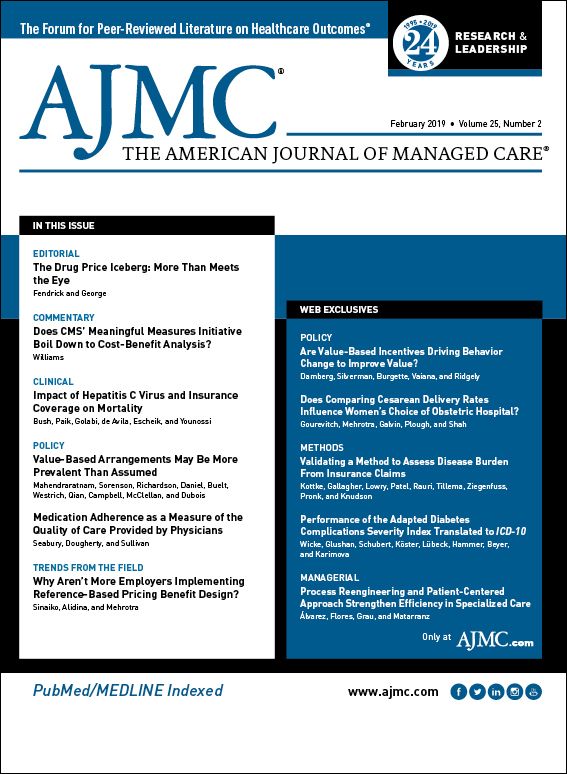- Center on Health Equity & Access
- Clinical
- Health Care Cost
- Health Care Delivery
- Insurance
- Policy
- Technology
- Value-Based Care
From the Editorial Board, February 2019: Sachin H. Jain, MD, MBA
Created in 1965, the Medicaid program was designed to provide care for the most vulnerable Americans. More than half a century later, the program has become tightly embedded in the nation’s healthcare system, due in part to its expansion under the Affordable Care Act (ACA). Today, Medicaid covers 1 in 5 Americans and finances nearly one-fifth of all healthcare spending. Although there is lingering political uncertainty about the exact future of Medicaid expansion and the ACA, the program is growing. In 2018, Idaho, Nebraska, and Utah became the latest states to adopt the ACA’s Medicaid expansion, bringing the total number to 37 (including Washington, DC).
As Medicaid expands, health plans and healthcare delivery organizations are learning how to make the program more effective and implementing new delivery models to improve outcomes for their Medicaid beneficiaries. Three trends have come to the forefront of Medicaid care. They are interrelated and we should expect to hear more about them in the future.
1. Predictive analytics. Building on the groundbreaking work of people like Jeffrey Brenner and the Camden Coalition, more and more organizations are using data-driven, patient-centered models to identify “outliers”—patients with complex, hard-to-manage needs and chronic conditions, as well as patients at high risk of developing these conditions. Those patients cost the most to treat, and organizations are finding that identifying them is the first step in designing effective interventions to treat them. Early identification can drive greater focus on the most expensive patients and ultimately result in lower costs.
2. Greater focus on social determinants of health. As we use data to identify outliers, we are also beginning to more broadly recognize a host of economic and social conditions that play a significant role in patient health. Income, nutrition, and housing are 3 commonly accepted social determinants. In my work, I’ve found that transportation is also a key social determinant; patients who can’t get to a doctor often don’t go to a doctor for preventive care. Loneliness, too, is an important factor—and we are learning that one’s connection to his or her community, measured by social capital, can help improve health. Increasingly, healthcare organizations are taking a broader look at patients’ whole health, leading them to both acknowledge the effects of these social determinants on health and look for new treatment methods that address them.
3. New delivery models. In the past, healthcare professionals simply waited for patients to arrive in their offices. But today, the most effective health organizations are proactive. They’re implementing multidisciplinary, coordinated care models that treat the whole patient—and that treatment often happens outside of hospitals and medical offices.
Shreya Kangovi, MD, MSHP, founding executive director of the Penn Center for Community Health Workers at the University of Pennsylvania, for example, has pioneered the hiring of people from within local communities to provide social support, advocacy, and navigation to high-risk individuals outside of the doctor’s office and within the communities in which they live.
At CareMore Health, the organization that I lead, we are reducing hospitalizations and producing better outcomes at lower costs through our “Primary Care Plus” model that integrates physical and behavioral health and extends care from the clinic to the home. In this case, members of clinical teams provide care in the clinic and visit the highest-risk patients at home.
What all of these approaches have in common—and share with many of the interventions described in this issue of The American Journal of Managed Care®—is that they’ve been developed alongside and often in response to the expansion of Medicaid coverage. They also put special emphasis on the “whole patient,” and we should expect them to improve care and make it more cost-effective in the future—and perhaps to have spillover effects by inspiring change in the care of commercially insured and Medicare-eligible patients. Better care for Medicaid beneficiaries is one important building block on our way to better care for all patients in the United States.

Trends in Hospital Pricing for Vulnerable Emergency Department Users, 2021-2023
December 4th 2025Self-pay emergency department prices rose significantly from 2021 to 2023, especially at for-profit and system-affiliated hospitals, highlighting growing affordability challenges for uninsured and underinsured patients.
Read More
Integrated Care for Chronic Conditions: A Randomized Care Management Trial
December 3rd 2025The authors sought to understand the differential impact of payer-led community-based care management approaches on stakeholder-oriented outcomes for publicly insured adults with multiple chronic conditions.
Read More

